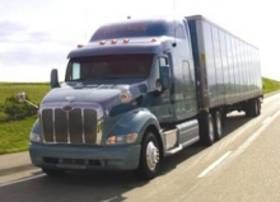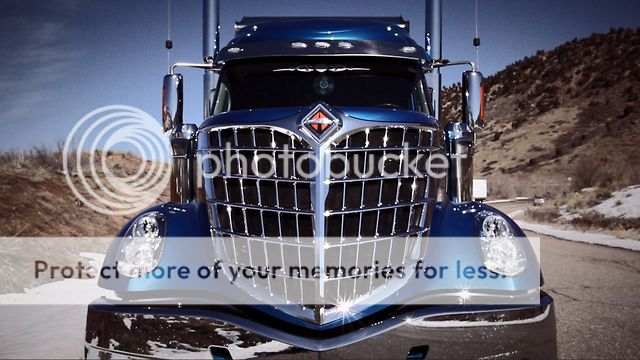About Gps...and Use Map..
Topic 985 | Page 2

We have a Rand Macnalley 510 trucking GPS on our truck. The other day I was driving across I80 in Western Utah across the Bonneville Salt Flats. It might be the longest straightest piece of interstate in the US. About 50 miles of dead straight road. Right about 2/3rds of the way across my GPS pipped up with "warning curve ahead".  She actually does this kind of thing all the time, and we think she was responding to an up coming exit. One advantage I have to a lot of truckers is, I have used GPS tech for close to 25 years in what I used to do. In the old days I used static tracking stations to provide ultra accurate coordinates on 1st order land surveying stations. We would set those up fr hours at a time, and often it would be at night, because that was when we had the best satellite coverage. You can track that into recent times when we had asll day and night coverage using one station along with static broadcast stations that have come along in most areas of the US. The bottom line is the satellite tracking on your units goes in and out. Your trucker GPS is as only as good as your last update. The maps they use can be based on maps done 100 years ago when roads were wagon trails. There have been so many people killed using GOS around death Valley, that the US Government stepped in and updated the maps to prevent people from using those old wagon trails in cars. (Seriously, park rangers spearheaded that because they got tired of finding dead people following GPS roads.) It is a great toll that has told of us of bad routes we were given directions for. It has also led us on some bad routes we did not want to take. The other night I got off an exit for a truck stop that the GPS had given me, and as soon as I got off the interstate, it told me my route had a weight violation, as I was pulling into the fuel isle at the Loves that it had taken me too. That was for a driver change because I had 20 minutes left on my clock.
She actually does this kind of thing all the time, and we think she was responding to an up coming exit. One advantage I have to a lot of truckers is, I have used GPS tech for close to 25 years in what I used to do. In the old days I used static tracking stations to provide ultra accurate coordinates on 1st order land surveying stations. We would set those up fr hours at a time, and often it would be at night, because that was when we had the best satellite coverage. You can track that into recent times when we had asll day and night coverage using one station along with static broadcast stations that have come along in most areas of the US. The bottom line is the satellite tracking on your units goes in and out. Your trucker GPS is as only as good as your last update. The maps they use can be based on maps done 100 years ago when roads were wagon trails. There have been so many people killed using GOS around death Valley, that the US Government stepped in and updated the maps to prevent people from using those old wagon trails in cars. (Seriously, park rangers spearheaded that because they got tired of finding dead people following GPS roads.) It is a great toll that has told of us of bad routes we were given directions for. It has also led us on some bad routes we did not want to take. The other night I got off an exit for a truck stop that the GPS had given me, and as soon as I got off the interstate, it told me my route had a weight violation, as I was pulling into the fuel isle at the Loves that it had taken me too. That was for a driver change because I had 20 minutes left on my clock.
Interstate:
Commercial trade, business, movement of goods or money, or transportation from one state to another, regulated by the Federal Department Of Transportation (DOT).
HOS:
Hours Of Service
HOS refers to the logbook hours of service regulations.OWI:
Operating While Intoxicated

I have the Rand 720 and I love it. I always use it in conjunction with the QualComm though. And if there's any conflicting info, I always refer to the QC. I'd say 90% of the time they match up however. What I love about my Rand is when I'm getting close to shutting down for the day, I can find all the truck stops along my route, or rest areas without any problems.
Qualcomm:
Omnitracs (a.k.a. Qualcomm) is a satellite-based messaging system with built-in GPS capabilities built by Qualcomm. It has a small computer screen and keyboard and is tied into the truck’s computer. It allows trucking companies to track where the driver is at, monitor the truck, and send and receive messages with the driver – similar to email.
I use two GPS's. My and Mcnally 720 ,which btw just had a major 6 hour update last week, and Google Maps on my Android. Between the two I have yet to be steered wrong. Plus I also use customer directions and my qualcomm directions.
Qualcomm:
Omnitracs (a.k.a. Qualcomm) is a satellite-based messaging system with built-in GPS capabilities built by Qualcomm. It has a small computer screen and keyboard and is tied into the truck’s computer. It allows trucking companies to track where the driver is at, monitor the truck, and send and receive messages with the driver – similar to email.
Im a local p/d driver in the sf bay area, i usually just use google maps to route myself, i have to drive on "no trucks" roads everyday to make my deliveries and pickups so ive never felt the need to buy a truck specific gps. Wouldnt do me much good in downtown san francisco haha.

During my most recent (starting CDL rating upgrade training tomorrow to go from Class "B" to Class "A") bout of OTR driving, I used both a Cobra HD6000 Truck GPS, Rand McNally Atlas & city/regional maps.
The GPS and city/regional maps to get to/from the interstate system to the shipper/consignee. The atlas and memory from doing LTL/Drop-n-hook driving years ago to get from city to city. I can only handle the GPS voice for short periods of time although both co-drivers couldn't get across the street without GPS so most of the time I had to put up with it the whole trip. Sad.
Now you know the second reason I'm upgrading my CDL...so I can run solo and not have to put up with co-drivers that refuse to learn (yes, I actually had the last co-driver flat out say "why learn it? You know how so we're good.")and push off most of the tasks of driving onto whoever their team partner is. The first reason is stated in our profile.
CDL:
Commercial Driver's License (CDL)
A CDL is required to drive any of the following vehicles:
- Any combination of vehicles with a gross combined weight rating (GCWR) of 26,001 or more pounds, providing the gross vehicle weight rating (GVWR) of the vehicle being towed is in excess of 10,000 pounds.
- Any single vehicle with a GVWR of 26,001 or more pounds, or any such vehicle towing another not in excess of 10,000 pounds.
- Any vehicle, regardless of size, designed to transport 16 or more persons, including the driver.
- Any vehicle required by federal regulations to be placarded while transporting hazardous materials.
Consignee:
The customer the freight is being delivered to. Also referred to as "the receiver". The shipper is the customer that is shipping the goods, the consignee is the customer receiving the goods.
Shipper:
The customer who is shipping the freight. This is where the driver will pick up a load and then deliver it to the receiver or consignee.
Regional:
Regional Route
Usually refers to a driver hauling freight within one particular region of the country. You might be in the "Southeast Regional Division" or "Midwest Regional". Regional route drivers often get home on the weekends which is one of the main appeals for this type of route.
LTL:
Less Than Truckload
Refers to carriers that make a lot of smaller pickups and deliveries for multiple customers as opposed to hauling one big load of freight for one customer. This type of hauling is normally done by companies with terminals scattered throughout the country where freight is sorted before being moved on to its destination.
LTL carriers include:
- FedEx Freight
- Con-way
- YRC Freight
- UPS
- Old Dominion
- Estes
- Yellow-Roadway
- ABF Freight
- R+L Carrier
OTR:
Over The Road
OTR driving normally means you'll be hauling freight to various customers throughout your company's hauling region. It often entails being gone from home for two to three weeks at a time.
Interstate:
Commercial trade, business, movement of goods or money, or transportation from one state to another, regulated by the Federal Department Of Transportation (DOT).
New Reply:
New! Check out our help videos for a better understanding of our forum features

















Preview:








 TT On Facebook
TT On Facebook
Thanks for the tip Starcar, that is one of many things I truly love about this awesome site. Tips and tricks from the experts.